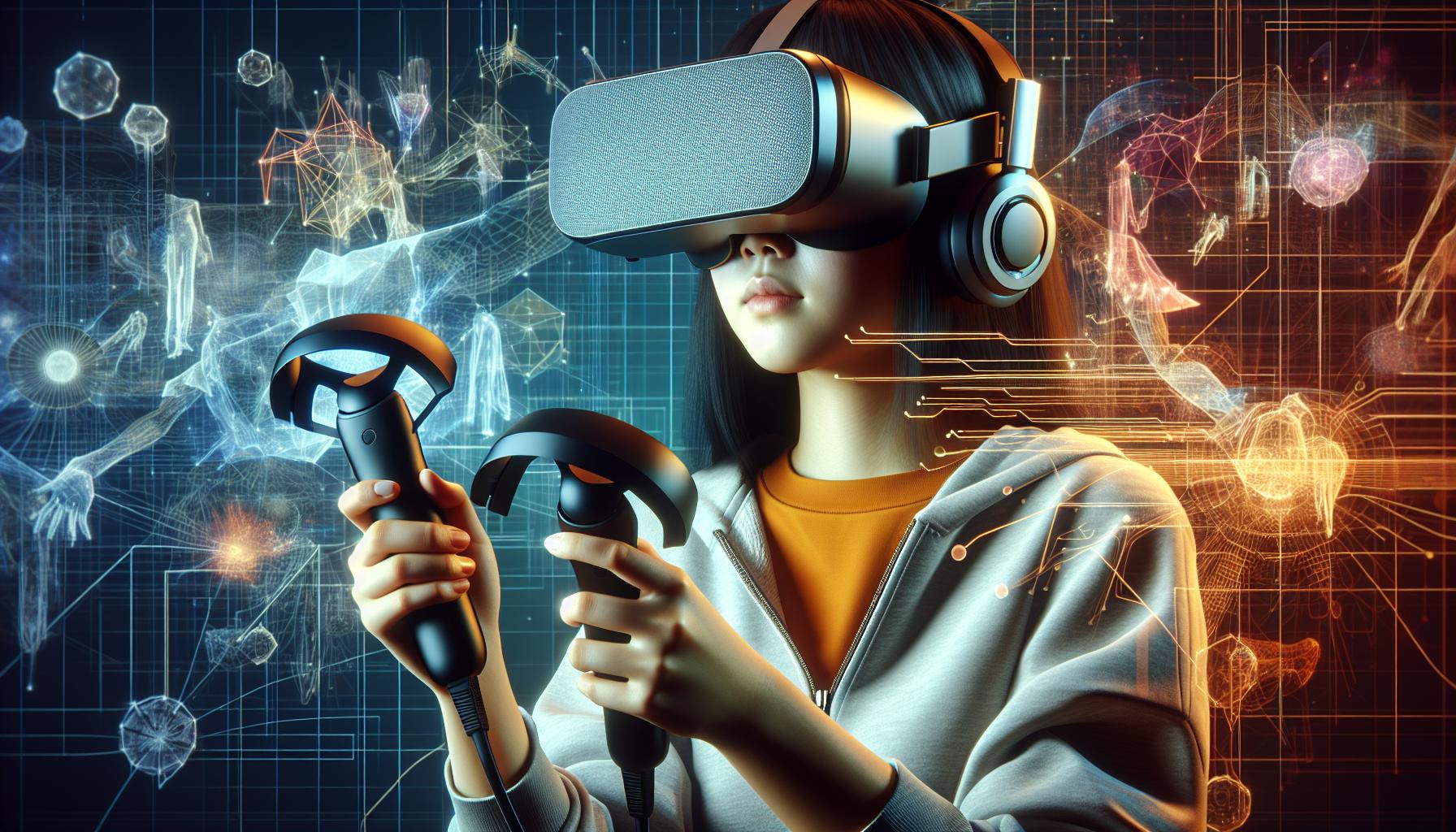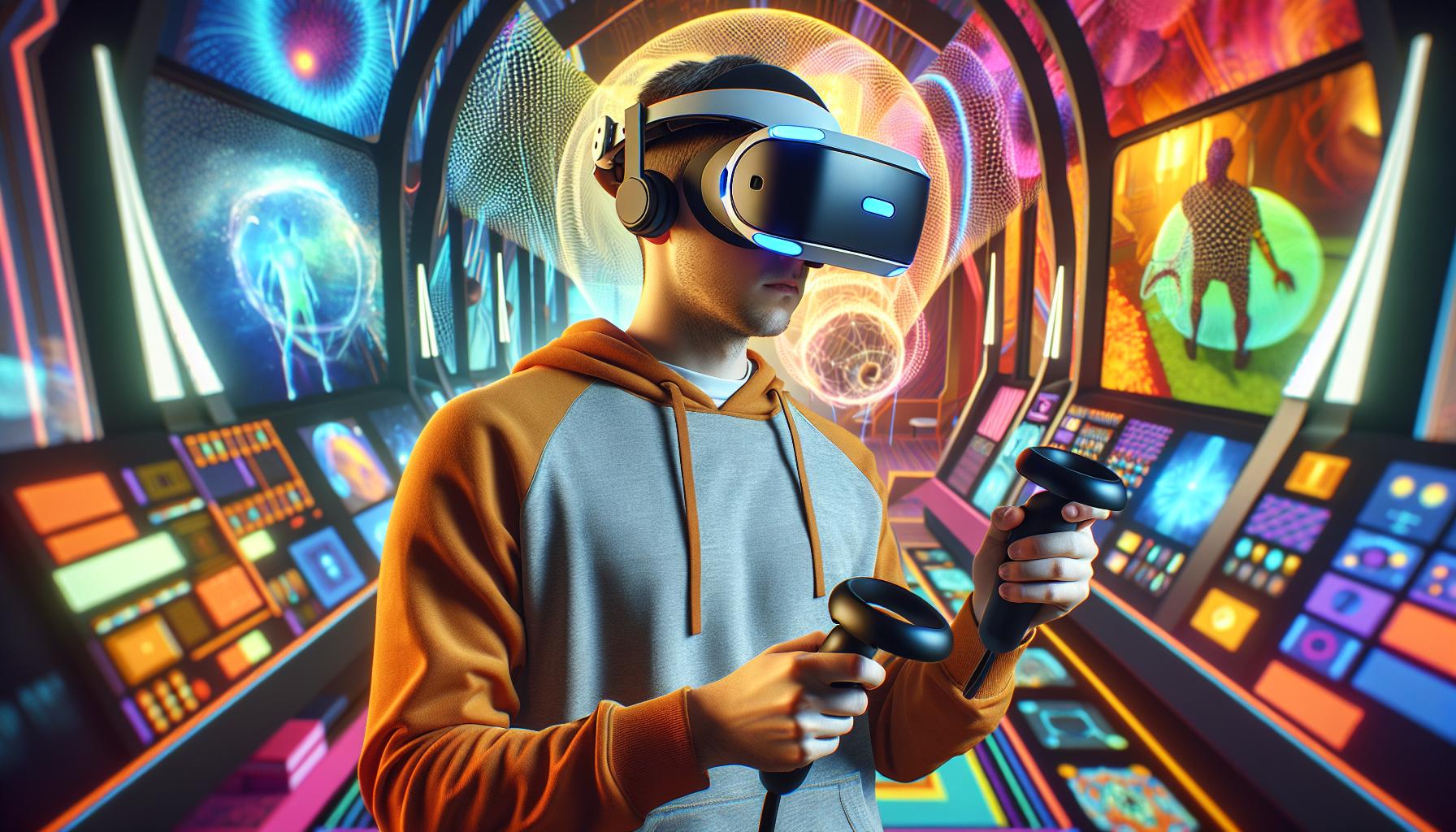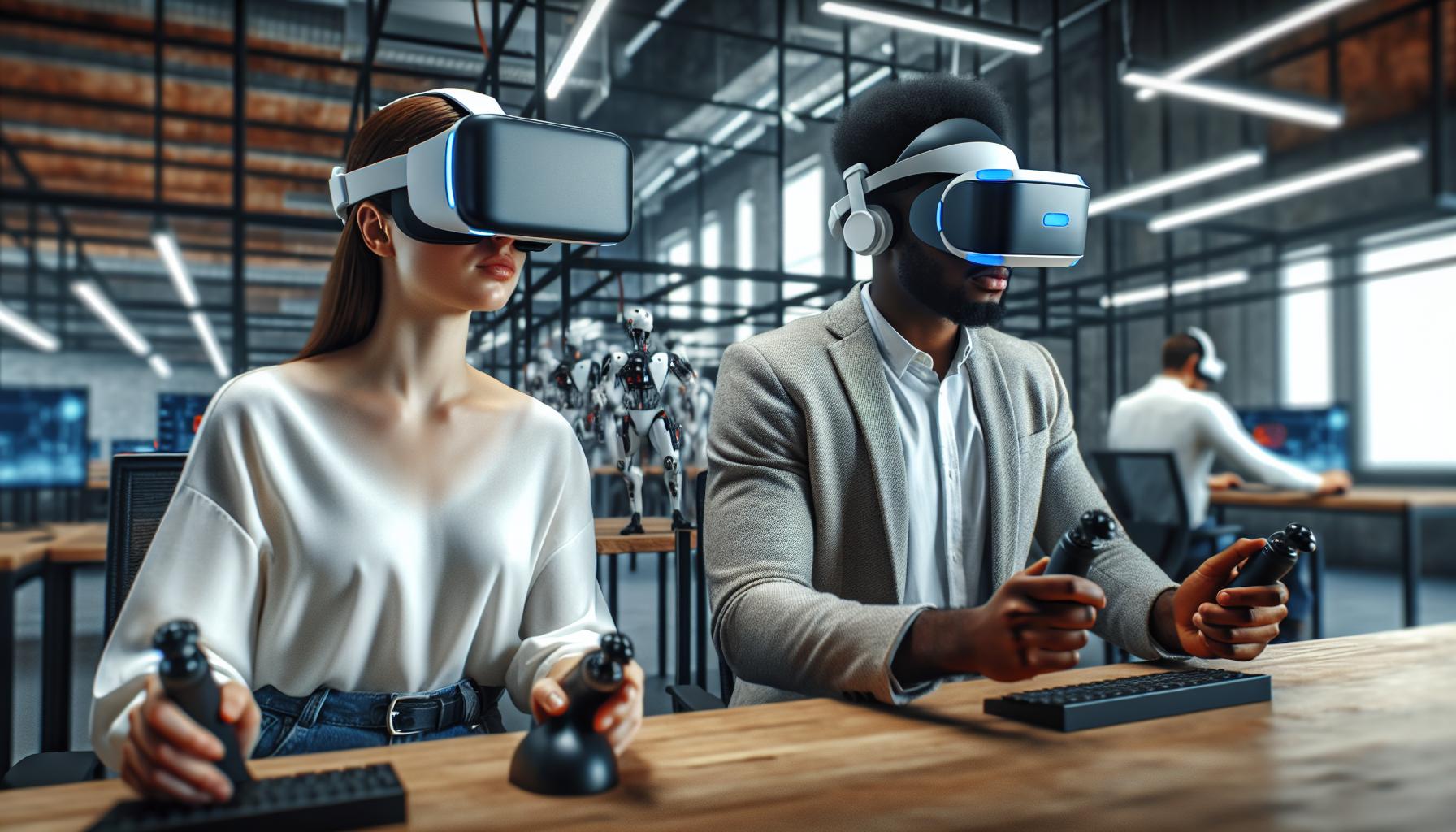Key Takeaways
- Immersive Experiences: Virtual reality systems provide users with fully interactive and engaging environments that enhance gaming, training, and educational experiences.
- Key Components: The primary components of VR systems include headsets, controllers, sensors, and powerful computing hardware, which work together to create immersive experiences.
- Wide Applications: VR is revolutionizing multiple industries, including gaming, healthcare, training, and remote collaboration, demonstrating its versatility and potential.
- Technological Advancements: Continuous improvements in hardware and software are making VR more accessible, with next-generation headsets offering higher resolutions and enhanced user experiences.
- Benefits and Challenges: While VR systems offer numerous advantages, such as cost efficiency and therapeutic uses, they also face challenges like high costs, motion sickness, and content availability that must be addressed.
- Future Potential: As VR technology evolves, its applications will expand further, making it a critical area for exploration and innovation in the tech landscape.
Virtual reality systems are revolutionizing the way people experience digital content. By immersing users in lifelike environments, these technologies transport them beyond the confines of their physical surroundings. Whether for gaming, training, or education, VR offers an unparalleled level of engagement that traditional media simply can’t match.
As the technology continues to evolve, the applications of virtual reality expand. From enhancing remote collaboration to transforming healthcare training, VR is reshaping industries and redefining human interaction. With advancements in hardware and software, the future of virtual reality promises even more exciting possibilities, making it a topic worth exploring for anyone interested in tech trends.
Virtual Reality Systems
Virtual reality (VR) systems comprise hardware and software designed to create simulated environments. These systems immerse users in 3D spaces, providing interactive experiences.
Key Components of VR Systems
- Headsets: Head-mounted displays (HMDs) provide visuals for users. Models like the Oculus Rift, HTC Vive, and PlayStation VR dominate the market.
- Controllers: Handheld devices track user movements and interactions. They allow users to manipulate virtual objects and navigate environments.
- Sensors: External sensors track user position and movements within the VR space. These add to user immersion by ensuring accurate real-time feedback.
- Software: Applications vary widely, including games, training programs, and simulations. Popular platforms include SteamVR and Oculus Store.
Applications of VR Systems
- Gaming: VR games offer immersive experiences that engage players in previously unattainable ways. Popular titles include Beat Saber and Half-Life: Alyx.
- Training: Industries utilize VR for realistic training simulations, from medical procedures to emergency response scenarios.
- Healthcare: VR aids in patient treatment and medical training, improving skills and outcomes through repeated practice in safe environments.
- Remote Collaboration: Teams use VR for virtual meetings, creating interactive spaces that enhance productivity and communication.
- Improved Hardware: Next-generation HMDs promise higher resolutions and wider fields of view. These advancements enhance visual experiences and reduce motion sickness.
- Enhanced Software Experiences: More sophisticated applications are in development, focusing on education, therapy, and entertainment.
- Increased Accessibility: Emerging platforms aim to make VR more affordable and user-friendly, expanding its reach and usability across demographics.
Virtual reality systems continue to evolve rapidly. This technology’s potential reshapes user interactions and experiences across diverse fields.
Types Of Virtual Reality Systems

Virtual reality systems fall into two main categories: immersive and non-immersive. Each type offers unique experiences tailored to different applications and user preferences.
Immersive Virtual Reality
Immersive virtual reality (IVR) provides users with a fully interactive digital environment. This type utilizes devices such as VR headsets, gloves, and motion-sensing controllers to create a sense of presence in a virtual space. Users can interact with their surroundings in real-time, enhancing the overall experience.
IVR is commonly used in gaming, where users navigate expansive worlds, solve puzzles, and engage in combat scenarios. In training simulations, industries like aviation and healthcare benefit from realistic environments that allow for hands-on practice without real-world consequences. For example, flight simulators provide pilots the chance to hone their skills in various conditions.
Non-Immersive Virtual Reality
Non-immersive virtual reality (NIVR) offers a less engaging experience compared to IVR. Users interact with a virtual environment through standard devices like computers or game consoles, often using a screen instead of a headset.
NIVR applications include 3D visualization, where users can explore virtual models and environments displayed on a flat screen. Educational programs use NIVR to create interactive lessons, allowing students to engage with content without needing complete immersion. This category also accommodates remote collaboration tools, where users can interact in virtual spaces via traditional interfaces.
Key Components Of Virtual Reality Systems

Virtual reality systems consist of essential hardware and software components that work together to create immersive experiences. Understanding these components provides insight into how VR functions across various applications.
Hardware Requirements
- Headsets: VR headsets act as the primary interface, providing visual displays and immersive environments. Popular models include the Oculus Quest 2 and Valve Index, which boast high resolutions and field-of-view capabilities.
- Controllers: Interactive controllers enhance user engagement by allowing manipulation of virtual objects. Devices like Oculus Touch and PlayStation Move offer various input methods, including gesture recognition and haptic feedback.
- Sensors: Sensors track user movements and position within the virtual space. Systems like external cameras and built-in sensors in headsets ensure accurate tracking, crucial for realistic experiences.
- Computing Power: A high-performance computer or console supplies the processing power required for complex graphics rendering. Minimum specifications typically include multi-core CPUs and dedicated GPUs, such as the NVIDIA GeForce GTX series.
- Operating System: Compatible operating systems, like Windows and macOS, support VR applications. Specific software environments may require additional configurations for optimal performance.
- VR Platforms: Software platforms, such as SteamVR or Oculus Store, distribute VR content. These platforms provide access to games and applications, enabling seamless integration with hardware components.
- Applications and Games: Specialized software creates the immersive experiences users seek. Examples include Beat Saber for gaming and educational simulations for training purposes, which cater to different user needs.
- Development Tools: For those creating VR content, software development kits (SDKs) like Unity or Unreal Engine facilitate the design and implementation of VR experiences. These tools offer various features to streamline the development process.
By integrating these hardware and software components, virtual reality systems deliver engaging and immersive digital environments across various sectors.
Benefits Of Virtual Reality Systems

Virtual reality (VR) systems provide numerous advantages that enhance user experiences across various domains.
- Immersive Experiences: VR creates fully interactive environments that immerse users in realistic scenarios. It engages multiple senses, making gaming and educational experiences more captivating.
- Enhanced Training Simulations: VR offers unparalleled training opportunities in various fields. Medical professionals utilize VR for surgical simulations, enabling hands-on practice without real-life consequences. Similarly, pilots use VR flight simulators to acquire skills in a safe setting.
- Improved Collaboration: VR fosters effective remote collaboration. Teams can meet in virtual spaces, working together on projects as if they were in the same room. This capability enhances teamwork and creativity, crucial for modern workplaces.
- Cost-Effective Solutions: VR reduces costs associated with physical training and educational materials. Organizations can simulate environments instead of providing physical equipment or resources, saving money while delivering quality experiences.
- Increased Accessibility: As technology advances, VR becomes more accessible to users. More affordable headsets and simplified interfaces allow a broader audience to engage with VR content, benefiting education and training sectors.
- Therapeutic Applications: VR’s impact extends into healthcare through therapeutic applications. Patients use VR for exposure therapy, helping them confront phobias or anxiety in controlled environments.
- Engaging Content Creation: VR encourages innovative content creation across industries. Developers create interactive experiences that captivate audiences, pushing the boundaries of storytelling and engagement.
- Social Connection: VR enhances social interactions by enabling users to connect in virtual environments. Friends and family can share experiences regardless of physical distance, reinforcing relationships in a unique way.
Each of these benefits contributes to the growing adoption of virtual reality systems across various industries, transforming how users interact with technology and each other.
Challenges And Limitations
Virtual reality systems face several challenges and limitations that impact user experience and adoption.
Cost
Cost represents a significant barrier, as high-quality VR headsets and compatible hardware can exceed $1,000 for comprehensive setups. Budget constraints may limit access for individuals and educational institutions, restricting reach.
Motion Sickness
Motion sickness affects many users during VR experiences. Symptoms such as dizziness, nausea, and headaches arise from the disconnect between visual motion and physical movement. Developers must create smoother experiences to mitigate these effects.
Content Availability
Content availability poses a limitation for VR systems. Developers create fewer applications than desired, particularly for niche markets. As a result, users may encounter a lack of engaging content that fully utilizes VR technology.
Technical Requirements
Technical requirements challenge widespread implementation. VR systems often require powerful computers or consoles capable of rendering high-quality graphics. Users without access to advanced hardware face compatibility issues that hinder smooth experiences.
User Comfort
User comfort remains a concern for VR systems. Prolonged use can cause discomfort from heavy headsets or restrictive controllers. Designing lighter and more ergonomic hardware is essential for enhancing user experience during extended sessions.
Social Acceptance
Social acceptance limits VR adoption, as some users express apprehension about immersive environments. Fears of isolation or social withdrawal may deter potential users from engaging with VR technology.
Physical Space
Physical space constraints affect where users can experience VR. Limited room may restrict movement, impacting engagement and immersion. Users benefit from designated VR spaces to ensure safety and enhance interaction.
These challenges underscore the necessity for continuous improvement in VR technology, leading to more accessible and user-friendly systems.
The Future of Virtual Reality
Virtual reality systems are reshaping how individuals engage with technology and each other. As advancements continue in hardware and software, the potential applications for VR expand across industries. From immersive gaming experiences to realistic training simulations and innovative healthcare solutions, the versatility of VR is undeniable.
While challenges remain, such as high costs and user comfort, ongoing developments promise to make VR more accessible and user-friendly. The future of virtual reality holds exciting possibilities that could further enhance productivity, creativity, and social interactions. As the technology evolves, its impact on daily life and professional environments will likely grow, making VR an integral part of the digital landscape.